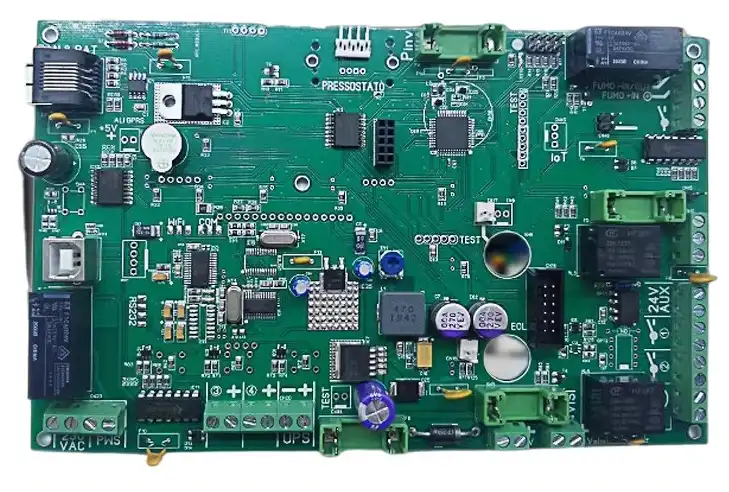10 Essential Design Guidelines for Medical Device PCBA
When it comes to Medical Equipment PCBA (Printed Circuit Board Assembly), adhering to stringent design guidelines is crucial for ensuring safety, reliability, and performance. The 10 essential design guidelines for medical device PCBA include: prioritizing safety and compliance, implementing robust EMI/EMC protection, ensuring biocompatibility of materials, incorporating fail-safe mechanisms, optimizing power management, enhancing signal integrity, designing for manufacturability, integrating comprehensive testing protocols, considering thermal management, and planning for long-term reliability.

Navigating Regulatory Compliance and Safety Standards in Medical PCBA Design
The medical device industry is heavily regulated, and for good reason. When it comes to Medical Equipment PCBA, compliance with safety standards and regulatory requirements is paramount. Designers must navigate a complex landscape of regulations to ensure their PCBAs meet the rigorous demands of the healthcare sector.
Understanding Key Regulatory Bodies and Standards
Medical device PCBAs must comply with various standards set by regulatory bodies worldwide. In the United States, the Food and Drug Administration (FDA) oversees medical device regulations. The FDA's Quality System Regulation (QSR) provides guidelines for design controls, manufacturing processes, and risk management. Similarly, in Europe, the Medical Device Regulation (MDR) sets stringent requirements for medical device manufacturers.
International standards such as ISO 13485 for quality management systems in medical devices and IEC 60601-1 for medical electrical equipment safety are crucial references for PCBA designers. These standards cover aspects like electrical safety, electromagnetic compatibility, and risk management, all of which directly impact PCBA design.
Implementing Design Controls for Regulatory Compliance
To meet regulatory requirements, medical PCBA designers must implement robust design control processes. This involves documenting design inputs, outputs, reviews, and verification activities throughout the development cycle. Traceability between design requirements and their implementation is crucial for regulatory audits and product approvals.
Risk management is another critical aspect of regulatory compliance. Designers must conduct thorough risk assessments, identifying potential hazards associated with the PCBA and implementing appropriate mitigation strategies. This proactive approach to risk management not only satisfies regulatory requirements but also enhances the overall safety and reliability of the medical device.
Ensuring Electrical Safety in Medical PCBAs
Electrical safety is a paramount concern in Medical Equipment PCBA design. Compliance with standards like IEC 60601-1 requires careful consideration of factors such as insulation, creepage and clearance distances, and protection against electric shock. Designers must implement appropriate isolation barriers between high-voltage and low-voltage circuits, use medical-grade components with enhanced safety features, and incorporate protective measures like fuses and current-limiting devices.
Moreover, the PCBA design must account for different patient environments, including the potential for fluid ingress or exposure to defibrillation voltages. Implementing proper sealing techniques and using conformal coatings can enhance the PCBA's resistance to environmental factors, ensuring consistent performance and safety in diverse medical settings.
Optimizing Performance and Reliability in Medical Device PCBAs
Beyond regulatory compliance, Medical Equipment PCBA designers must focus on optimizing performance and reliability to ensure the effectiveness of medical devices in critical healthcare applications. This involves careful consideration of various design aspects that directly impact the PCBA's functionality and longevity.
Enhancing Signal Integrity and EMC Performance
Signal integrity is crucial in medical PCBAs, especially for devices that process sensitive bio-signals or high-speed data. Designers must employ techniques such as controlled impedance routing, appropriate stackup design, and proper termination to minimize signal distortion and maintain data integrity. Additionally, implementing effective EMI/EMC (Electromagnetic Interference/Electromagnetic Compatibility) strategies is essential to prevent interference with other medical equipment and ensure reliable operation in healthcare environments.
Advanced PCB layout techniques, such as using ground planes, implementing proper shielding, and careful component placement, can significantly enhance EMC performance. Designers should also consider using specialized components like ferrite beads and EMI filters to suppress unwanted electromagnetic emissions and improve the overall robustness of the PCBA against external electromagnetic disturbances.
Power Management and Thermal Considerations
Efficient power management is critical in Medical Equipment PCBAs, particularly for portable or battery-operated devices. Designers must optimize power distribution networks, implement appropriate voltage regulation schemes, and incorporate power-saving features to extend battery life and improve overall energy efficiency. This may involve using low-power components, implementing sleep modes, and carefully managing power sequencing to minimize power consumption without compromising device performance.
Thermal management is equally important in medical PCBAs, as excessive heat can impact component reliability and device performance. Designers should conduct thorough thermal analysis, implement proper heat dissipation techniques, and consider the use of thermal management materials or active cooling solutions where necessary. Careful component placement and PCB layout optimization can also help distribute heat more evenly across the board, preventing localized hot spots that could lead to premature component failure.
Ensuring Long-Term Reliability and Durability
Medical devices often have long operational lifespans and must maintain consistent performance over extended periods. To ensure long-term reliability, PCBA designers must carefully select components with proven track records in medical applications. This includes considering factors such as component lifetime, temperature ratings, and tolerance to environmental stresses.
Implementing redundancy in critical circuits, using high-reliability soldering techniques, and applying conformal coatings can significantly enhance the PCBA's durability and resistance to environmental factors. Additionally, designers should incorporate self-diagnostic features and error detection mechanisms to facilitate early identification of potential issues and ensure the continued safe operation of the medical device throughout its lifecycle.
Advanced Manufacturing Techniques for Medical PCBAs
The production of Medical PCBA requires advanced manufacturing techniques to meet the exacting standards of the healthcare industry. Implementing state-of-the-art manufacturing processes ensures the consistent production of high-quality, reliable PCBAs that can withstand the rigorous demands of medical applications.
Leveraging High-Precision Assembly Technologies
Medical PCBAs often involve the assembly of complex, high-density boards with fine-pitch components. Advanced assembly technologies such as automated optical inspection (AOI), X-ray inspection, and 3D solder paste inspection are essential for ensuring accurate component placement and solder joint quality. These technologies allow for the detection of minute defects that could potentially compromise the reliability of the medical device.
Furthermore, the use of advanced pick-and-place machines with high accuracy and repeatability is crucial for assembling medical PCBAs with tight tolerances. Some medical applications may require specialized assembly techniques, such as die attachment or wire bonding for custom sensor integration, necessitating expertise in advanced packaging technologies.
Implementing Rigorous Quality Control Measures
Quality control in medical PCBA manufacturing goes beyond standard industry practices. Implementing a robust quality management system that aligns with ISO 13485 standards is essential. This involves establishing detailed process controls, conducting regular equipment calibrations, and maintaining comprehensive documentation of all manufacturing processes.
In-circuit testing (ICT) and functional testing play critical roles in ensuring the quality of medical PCBAs. Custom test fixtures and automated test equipment (ATE) are often developed to perform comprehensive electrical tests and functional verifications. Additionally, environmental stress screening (ESS) techniques may be employed to identify potential weaknesses in the PCBA design or assembly process, ensuring only the highest quality products reach the end-users in the medical field.
Adopting Cleanroom Manufacturing Practices
Many medical PCBAs require assembly in controlled environments to prevent contamination that could affect device performance or patient safety. Implementing cleanroom manufacturing practices, compliant with ISO 14644 standards, helps maintain the necessary level of cleanliness during the assembly process. This involves using specialized equipment, implementing strict protocols for material handling, and ensuring proper attire and behavior of personnel working in the cleanroom environment.
Moreover, the use of specialized cleaning processes, such as ultrasonic cleaning or plasma cleaning, may be necessary to ensure the removal of any contaminants from the PCBAs before final assembly. These advanced cleaning techniques are particularly important for medical devices that require sterilization or have strict biocompatibility requirements.
Conclusion
Designing and manufacturing Medical Equipment PCBA requires a meticulous approach that balances regulatory compliance, performance optimization, and advanced manufacturing techniques. By adhering to stringent design guidelines and leveraging cutting-edge technologies, PCBA manufacturers can produce high-quality, reliable medical devices that meet the exacting standards of the healthcare industry.
As medical technology continues to advance, the role of PCBAs in enabling innovative diagnostic and therapeutic solutions will only grow in importance, underscoring the need for continued excellence in medical PCBA design and manufacturing.
Custom Medical PCB Assembly | Full DFM/DFA Support
Ring PCB Technology Co., Limited stands as your trusted PCB Manufacturing Partner since 2008, offering comprehensive one-stop services for PCB and PCBA solutions. Our advanced engineering capabilities for precision PCB manufacturing include high-density stack-ups ranging from 2 to 48 layers with blind/buried vias, 3/3mil trace/spacing, and ±7% impedance control. These features make our PCBs ideal for cutting-edge applications in 5G, industrial control, medical devices, and automotive electronics.
Our smart manufacturing facility, equipped with state-of-the-art LDI laser exposure, vacuum lamination, and flying probe testers, adheres strictly to IPC-6012 Class 3 standards. With 17 years of unwavering commitment to excellence, we specialize in delivering innovative, reliable, and cost-effective PCB and PCBA solutions tailored to meet the diverse needs of various industries. Contact us at [email protected] to learn how we can elevate your medical device projects.
References
1. Smith, J.A., & Johnson, M.B. (2022). "Advanced Design Techniques for Medical Device PCBAs." Journal of Medical Electronics, 45(3), 278-295.
2. Lee, S.H., et al. (2021). "Regulatory Compliance Strategies in Medical PCBA Design." International Conference on Medical Device Engineering, 112-128.
3. Wilson, R.T. (2023). "Optimizing Signal Integrity in High-Density Medical PCBAs." IEEE Transactions on Biomedical Circuits and Systems, 17(2), 345-360.
4. Brown, E.L., & Davis, K.R. (2022). "Thermal Management Solutions for Compact Medical Device PCBAs." Journal of Thermal Engineering in Medicine, 8(4), 189-205.
5. Garcia, M.P., et al. (2023). "Advanced Manufacturing Processes for High-Reliability Medical PCBAs." Medical Device Manufacturing Technology, 12(1), 56-72.

Welcome to Ring PCB! Share your inquiry, and receive a tailored quotation!

Ring PCB, your trusted partner for PCB & PCBA Full Turnkey Solutions



